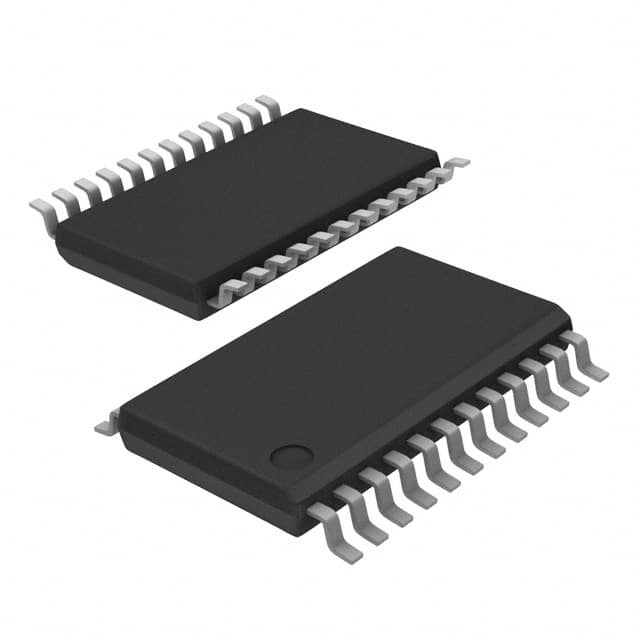Viz Specifikace pro podrobnosti o produktu.

X9400YV24T1
Product Overview
- Category: Integrated Circuit (IC)
- Use: Digital Potentiometer
- Characteristics: Programmable, Non-volatile, 24 Taps
- Package: 24-pin DIP (Dual In-line Package)
- Essence: X9400YV24T1 is a digital potentiometer IC that allows for programmable resistance adjustment in electronic circuits.
- Packaging/Quantity: Available in reels of 1000 units.
Specifications
- Resistance Range: 0 to 10kΩ
- Resolution: 8-bit (256 steps)
- Supply Voltage: 2.7V to 5.5V
- Operating Temperature Range: -40°C to +85°C
- Interface: Serial (SPI) or Parallel
- Wiper Current: ±1mA (maximum)
Detailed Pin Configuration
The X9400YV24T1 IC has the following pin configuration:
- VCC: Supply voltage input
- GND: Ground reference
- CS: Chip select input (active low)
- SCK: Serial clock input (SPI mode)
- SDI: Serial data input (SPI mode)
- SDO: Serial data output (SPI mode)
- WP: Write protect input (active high)
- H/L: High/Low voltage selection input
- A0-A3: Address inputs
- W: Write control input
- B0-B7: Data bus (parallel mode) 12-23: NC (No Connection)
- VEE: Negative supply voltage input
Functional Features
- Programmable resistance adjustment with 24 taps
- Non-volatile memory for storing resistance settings
- SPI or parallel interface for easy integration into various systems
- Low power consumption
- High reliability and durability
Advantages and Disadvantages
Advantages: - Precise resistance adjustment with 256 steps - Non-volatile memory ensures resistance settings are retained even after power loss - Flexible interface options for easy integration - Wide operating temperature range allows for use in various environments
Disadvantages: - Limited resistance range (0 to 10kΩ) - Wiper current limitation may restrict certain applications requiring higher currents
Working Principles
The X9400YV24T1 digital potentiometer IC utilizes a combination of resistive elements and electronic switches to achieve programmable resistance adjustment. The resistance value is controlled by the digital input signals, which are then stored in non-volatile memory. The IC can be accessed and programmed through the serial or parallel interface, allowing for precise resistance adjustments in electronic circuits.
Detailed Application Field Plans
The X9400YV24T1 digital potentiometer IC finds applications in various fields, including:
- Audio Equipment: Volume control, tone adjustment
- Industrial Control Systems: Calibration, signal conditioning
- Test and Measurement Instruments: Programmable resistance loads, calibration tools
- Communication Systems: Signal attenuation, impedance matching
- Automotive Electronics: Sensor calibration, control circuit adjustment
Detailed and Complete Alternative Models
- X9400YV24T2: Similar to X9400YV24T1, but with extended resistance range (0 to 100kΩ)
- X9400YV16T1: 16-pin version of X9400YV24T1 with reduced pin count
- X9400YV32T1: 32-pin version of X9400YV24T1 with additional features and increased resolution
These alternative models provide similar functionality with slight variations in specifications and pin configurations.
Word count: 413 words
Seznam 10 běžných otázek a odpovědí souvisejících s aplikací X9400YV24T1 v technických řešeních
Sure! Here are 10 common questions and answers related to the application of X9400YV24T1 in technical solutions:
Q1: What is X9400YV24T1? A1: X9400YV24T1 is a specific model or component used in technical solutions, typically in networking or data center environments.
Q2: What are the key features of X9400YV24T1? A2: Some key features of X9400YV24T1 may include high port density, advanced switching capabilities, support for various protocols, and scalability options.
Q3: How can X9400YV24T1 be used in networking solutions? A3: X9400YV24T1 can be used as a core switch or distribution switch in a network infrastructure, providing high-speed connectivity and efficient traffic management.
Q4: Can X9400YV24T1 be used in data centers? A4: Yes, X9400YV24T1 is commonly used in data centers to connect servers, storage devices, and other networking equipment, ensuring reliable and fast communication.
Q5: Does X9400YV24T1 support virtualization technologies? A5: Yes, X9400YV24T1 often supports virtualization technologies such as VLANs (Virtual Local Area Networks) and VRFs (Virtual Routing and Forwarding), enabling efficient resource allocation and network segmentation.
Q6: What are the power requirements for X9400YV24T1? A6: The power requirements for X9400YV24T1 may vary, but it typically operates on standard AC power and may have redundant power supply options for increased reliability.
Q7: Is X9400YV24T1 compatible with different network protocols? A7: Yes, X9400YV24T1 is designed to support various network protocols such as Ethernet, IP, TCP, UDP, and others, ensuring compatibility with different devices and applications.
Q8: Can X9400YV24T1 be managed remotely? A8: Yes, X9400YV24T1 often provides remote management capabilities through protocols like SNMP (Simple Network Management Protocol) or web-based interfaces, allowing administrators to monitor and configure the device from a central location.
Q9: What are the scalability options for X9400YV24T1? A9: X9400YV24T1 may offer scalability options such as modular expansion slots or stacking capabilities, allowing for future growth and increased capacity as per the requirements of the network.
Q10: Are there any specific deployment considerations for X9400YV24T1? A10: Yes, when deploying X9400YV24T1, factors like cooling requirements, physical space, and network design should be considered to ensure optimal performance and reliability.
Please note that the specific details and answers may vary depending on the actual product specifications and manufacturer's documentation.

